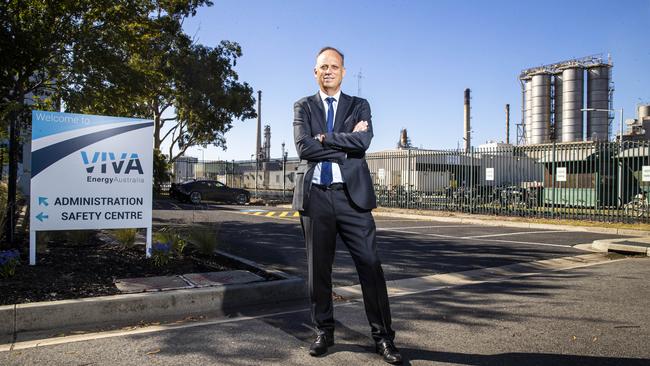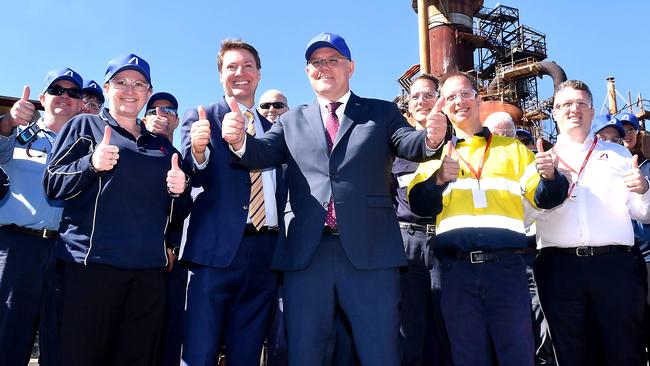Ampol, Viva cash in on refinery rescue package
The closure of BP and Exxon refineries were an extra spur for the government’s stronger-than-expected aid for Ampol and Viva Energy.

The federal government‘s $2.3bn refinery rescue package has sparked a series of upgrades and higher share price targets for Ampol and Viva Energy, with the taxpayer subsidies easing earnings volatility.
The rescue scheme keeps 1250 workers in jobs and two of the nation’s major manufacturing facilities open at Brisbane’s Lytton and Victoria’s Geelong plants.
Shares in Ampol and Viva surged on Monday, with analysts pondering whether companies would use the earnings certainty to give money back to investors or embark on takeover deals.
Ampol was upgraded to overweight from equalweight by Morgan Stanley and its price target lifted to $31.70 from $30 with the prospect of baked in returns should refining margins run higher amid a global recovery.
The refining package “will give the investment community more confidence that both companies can hit 2022 consensus forecasts. For the next leg of upside, global refinery margins need to improve and balance sheet optionality at Ampol is looking interesting,” Morgan Stanley analyst Adam Martin said.
Ampol’s refining earnings before interest and tax will increase by $63m in the 2021 financial year and $45m in FY22 with Viva’s earnings forecast to rise by $24m and $60m over the next two years, Morgan Stanley said.
The closure of the BP and Exxon refineries gave extra motivation for the government to sanction the package, which was far stronger than industry expectations, Macquarie said, as it lifted its Ampol price target by 8 per cent to $34.80 a share and Viva by 9 per cent to $2.35 a share.
“The combination of the fuel security services payment, 50 per cent funding grant for clean fuels capital expenditure - and potentially 100 per cent of certain other future projects - and what is likely to be a tangible benefit from stricter diesel stockholding obligations is far better than we had thought the government would be willing to support,” Macquarie told clients.
“We see 29 per cent upside to Ampol and believe the conclusion of government negotiations represents another key win for new management following the property trust and $300m buyback.”

UBS rates both Ampol and Viva a buy, with the broker lifting Ampol’s price target to $33.50 from $30.90 and identifying up to $650m of the company’s capital could be deployed into growth or capital management.
“We believe Ampol will preference deploying capital towards growth given: i) Ampol‘s comments that the support package could be a catalyst for consolidation of infrastructure across industry; (ii) potential opportunities to expand Kurnell storage capacity; iii) new decarbonisation opportunities at the site of the Lytton refinery to be clarified later this week,” UBS said.
UBS lifted Ampol‘s earnings per share forecasts by 10 to 17 per cent for the 2021-23 financial years.
Viva’s price target was boosted to $2.35 by UBS from $2 previously with its earnings per share estimates raised by up to 32 per cent through the 2023 financial year to reflect additional earnings provided by the fuel production subsidy.
Ampol’s price target was also increased to $28 from $27 by RBC with a sector perform rating retained.
“A more predictable earnings stream implies the market may now be willing to assign an improved valuation EBITDA multiple to Ampol’s refining operations,” RBC said.
Fears have been growing the nation’s refining sector could disappear entirely in the face of falling demand brought on by the pandemic and competition from far larger refineries in Singapore, South Korea, Japan and elsewhere in Asia.
Consumers may have paid an extra 1c a litre for petrol if all refineries were to close in Australia, government modelling showed.
The variable Fuel Security Service Payment increases when refineries’ margins are low and tapers off when profits are high, hitting $2.04bn by 2030 under a worst-case scenario.



To join the conversation, please log in. Don't have an account? Register
Join the conversation, you are commenting as Logout